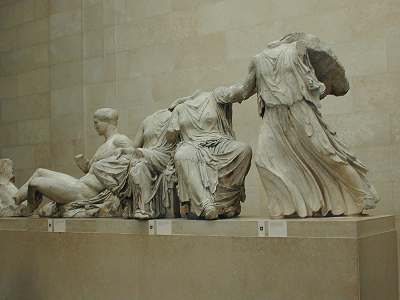
The front of the British Museum.

The glass ceiling of the Great Court of the museum..

The upper half of a statue of Rameses II, who was likely
the Pharaoh in power when Moses asked to "Let my people go." (1270
BC)

An Assyrian statue of a winged lion with a human head . (C 870 BC)

One set of statues of the pediment of the Parthenon.
If you don't remember what a pediment is, look back at the triangular
area in the picture of the museum above. See how these statues
would have fit into the pediment of the Parthenon.

Here are the statues of the other side of the pediment.

This a picture of about half of the Elgin marbles. These made up the frieze, or the decoration just under the roof of the Parthenon.

A closeup of some of the figures in the frieze.

A docent was showing some Roman coins. These are
denarii, which Christ referred to in his "Render unto Caesar the things that
are Caesar's" stament in Matthew 22:19. We were excited to be able
to handle and photograph them. For a larger view of other coins
she had on display, check this link

One of Hadrians's sestercii.

Elizabeth holding a Greek Shekel from the 3rd century
BC. Check this link to see more Greek coins.

This watercolor by Adrian van Ostade was one example.
We also enjoyed the special exhibition of "Breugel to Rembrandt" in the Prints and Drawings section. This exhibit had over 100 wonderful drawings by Dutch artists in pencil, ink, chalk, wash, watercolor and combinations of these. These are works from the world's outstanding private collection of Dutch 17th century drawings, collected by Maida and George Abrams, a couple from Boston, Massachusetts.

This watercolor by Adrian van Ostade was one example.
Continue to Day 8.